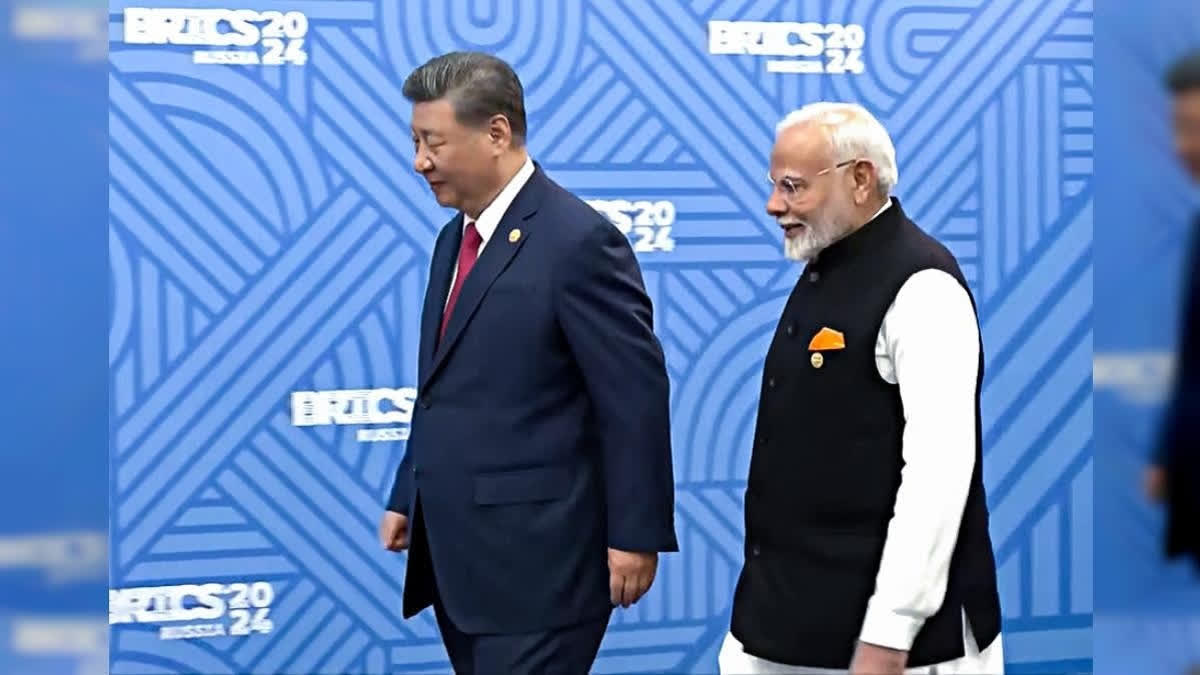New Delhi: A flurry of high-level meetings has significantly shifted the diplomatic landscape between China and India, fostering a more optimistic and collaborative mood in their interactions. But this raises a question: Is a thaw in the making?
In conversation with ETV Bharat, Dr Aravind Yelery, an Honorary Fellow at the Institute of Chinese Studies, Delhi and Associate Professor at the Centre for East Asian Studies, Jawaharlal Nehru University, said, "Even if both sides take small, incremental steps towards cooperation, it will still be a daunting task for China to convince India of its sincerity and reliability. We are still at the early stages of understanding each other, and it's clear that a mutual agreement is still a long way off”.
He said, "The recent discussions indicate a notable shift in urgency from the Chinese side regarding their engagement with India. India is also keen on establishing some agreement to address ongoing issues; however, as of now, nothing has been resolved. We are still at the pre-negotiation stage, where both sides are trying to prepare for a more conducive environment for dialogue. There seems to be increasing pressure on China, influenced by the changing dynamics of geopolitics in Central Asia and Eurasia. This pressure may be driving China to pursue stronger engagements with India, possibly to create conditions favourable for collaboration".
"While China appears to view this as an opportunity, India faces significant challenges, primarily due to historical breaches of trust from China that have occurred over the past few years. The trust that was built has been eroded, particularly in 2017, 2019, and 2020, and the impacts of these events are likely to linger into the coming decade”, added Dr Yelery.
On Thursday, December 5, during the 32nd meeting of the Working Mechanism for Consultation & Coordination on India-China Border Affairs (WMCC), the two sides positively affirmed the implementation of the most recent disengagement agreement which completed the resolution of the issues that emerged in 2020. They also prepared for the next meeting of the Special Representatives, which is to be held by the decision of the two leaders in their meeting in Kazan on 23 October 2024.
According to the Ministry of External Affairs, both sides reviewed the situation in border areas and reflected on the lessons learnt from the events of 2020 to prevent their recurrence. In this context, they highlighted the importance of regular exchanges and contacts at the diplomatic and military levels through established mechanisms. They agreed on the need for effective border management and maintenance of peace & tranquillity by relevant bilateral agreements, protocols and understandings between the two Governments. The leader of the Chinese delegation also called on the Foreign Secretary during the visit.
On October 21, Foreign Secretary Vikram Misri announced in Delhi that a significant agreement had been finalised between the two sides to disengage at the remaining friction points at the LAC in eastern Ladakh, after extensive negotiations spanning several weeks. This agreement is expected to address and resolve the various issues that arose during 2020, reflecting a commitment to improving regional stability.
Just a couple of days later, on October 23, during their official bilateral meeting on the sidelines of the BRICS Summit in Kazan, Russia, Prime Minister Narendra Modi and Chinese President Xi Jinping publicly endorsed the newly established agreement. This agreement focuses on patrolling and disengagement along the Line of Actual Control (LAC) in eastern Ladakh, signalling a mutual effort to ease tensions and promote peace between the neighbouring nations.
In his first statement in the Parliament, since India and China have reached an agreement, External Affairs Minister Dr S Jaishankar said that the recent conclusion of disengagement has set the ties in the direction of some improvement.
“Our ties have been abnormal since 2020 when peace and tranquillity in the border areas were disturbed because of Chinese actions. Recent developments that reflect our continuous diplomatic engagement since then have set our ties in the direction of some improvement”.
“The situation arising after our counter-deployment in 2020 called for multiple sets of responses. The immediate priority was to ensure disengagement from friction points so that there would be no further untoward incidents or clashes. Now that it has been fully achieved, the next priority will be to consider de-escalation, which would address the massing of troops along the LAC with associated accompaniments. It is also evident that the management of the border areas will require further attention in the light of our recent experiences,” Jaishankar noted.
Further, when asked about the promise and perils of India-China ties and the possible geopolitical implications, Dr Aravind Yelery said, “From the Indian side, we want to make it clear to China that we will not compromise on any issues related to the Line of Actual Control (LAC). We believe that China has not respected agreements to keep peace along the LAC. This disregard has been significant."
"From India’s perspective, we need to communicate that we prioritize national security and expect both sides to honour agreements. The main points for India in this situation are that China has broken its promises, we want to move forward on our terms, and there is increasing pressure on China from Russia and other countries to cooperate with India," added Yelery.
"The issue at the India-China border is no longer just a matter between the two countries. It has international implications as well. Given this, China has been pushed to engage in discussions and has agreed to some Indian points. They have acknowledged the need to continue discussions on petroleum, which they had previously halted for several years. This situation raises important questions about China’s intentions and its respect for its neighbours. These issues present challenges for China on the international stage," the expert elaborated.
"Looking ahead, I believe China will only engage with India in de-escalation discussions if they see a benefit. We have noticed that China is more likely to engage when they are facing difficulties. For example, just before events like BRICS, there was considerable pressure from China to have leaders meet, which eventually happened. After recent discussions, national security advisors are now meeting, and it's worth noting that China will chair the Shanghai Cooperation Organization next year. They will likely seek more engagement from India, especially since Russia is encouraging China to involve India more. These dynamics put pressure on China more than India's internal security concerns regarding boundary issues”, the expert explained.
Meanwhile, Former Indian ambassador Anil Trigunayat told ETV Bharat that the trust between India and China, which lasted for 40 years, was broken in 2020. He expressed scepticism that mere de-escalation and disengagement could ensure long-term peace, emphasising that border issues need to be genuinely resolved through proactive diplomacy.
Trigunayat noted that many partners in BRICS and West Asia have heaved a sigh of relief as some rapprochement has begun following the meeting between PM Modi and President Xi Jinping in Kazan since they favour a stable relationship between the two major powers.
However, he pointed out that despite China being India's primary or secondary trading partner, issues like trade deficits and market access remain problematic. Both nations do collaborate in international forums like the WTO and climate change negotiations, but he acknowledged that the evolving geopolitical landscape would continue to present challenges for India concerning China.



